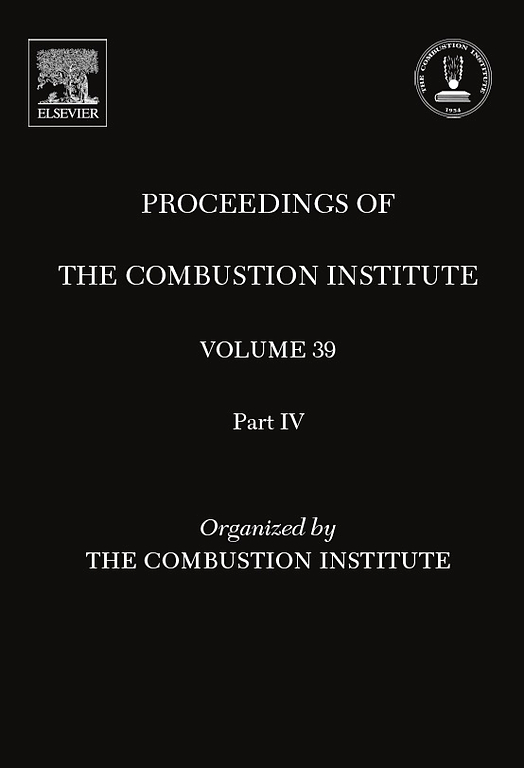Effect of simultaneous H2 and NH3 addition on soot formation in co-flow diffusion CH4 flame
IF 5.3
2区 工程技术
Q2 ENERGY & FUELS
引用次数: 0
Abstract
Simultaneous blending of hydrogen (H) and ammonia (NH) to hydrocarbon fuels can tackle the safety issues of H and improve burning efficiency of NH. While this strategy brings challenges for soot prediction due to the promotion effect of H and the suppression effect of NH, and the interactions between H and NH. In this study, the simultaneous addition of NH and H on soot formation was experimentally and numerically investigated in a co-flow diffusion CH flame. The interactions between NH and H, and how they impacted different soot formation processes were comprehensively revealed using a detailed soot sectional model. The decrease of peak SVF in CH flame caused by NH was 0.013 ppm, about 31.6 % smaller than that in CH/H flame (0.019 ppm), indicating that the inhibitive effect of NH on soot formation was promoted by H. The existence of H promoted the suppression effect of NH on soot nucleation, condensation and HACA processes in the CH flame. Compared with CH/NH flame, the pyrolysis rates of NH, NH and NH in the CH/NH/H flame were higher since more H and OH radicals were generated via H decomposition. This led to a larger consumption rate of H and OH radicals, which decreased the reaction rates of CH+OH=CH+HO and CH+OH=CH+HO, and promoted the combination of NO and CH. Both factors accounted for a stronger suppression effect of NH on the formation of A1 in CH/H flame than that in CH flame, and thus a stronger inhibitive effect on soot inception and condensation. Compared with the CH flame, NH resulted in a larger decline of H and OH radicals mole fractions in the CH/H flame, which explained the stronger suppression effect of NH on the HACA surface growth process in the CH/H flame.同时添加 H2 和 NH3 对同流扩散 CH4 火焰中烟尘形成的影响
在碳氢化合物燃料中同时掺入氢气(H)和氨气(NH)可解决 H 的安全问题并提高 NH 的燃烧效率。但由于氢气的促进作用和氨气的抑制作用,以及氢气和氨气之间的相互作用,这种策略给烟尘预测带来了挑战。本研究在同流扩散 CH 火焰中对同时添加 NH 和 H 对烟尘形成的影响进行了实验和数值研究。通过详细的烟尘断面模型,全面揭示了 NH 和 H 之间的相互作用以及它们如何影响不同的烟尘形成过程。在CH火焰中,NH导致的SVF峰值下降为0.013 ppm,比CH/H火焰中的SVF峰值(0.019 ppm)小约31.6%,表明H促进了NH对烟尘形成的抑制作用。与 CH/NH 火焰相比,CH/NH/H 火焰中 NH、NH 和 NH 的热分解率更高,因为 H 分解产生了更多的 H 和 OH 自由基。这导致 H 和 OH 自由基的消耗率增大,从而降低了 CH+OH=CH+HO 和 CH+OH=CH+HO 的反应速率,并促进了 NO 和 CH 的结合。这两个因素导致 NH 在 CH/H 火焰中对 A1 形成的抑制作用比在 CH 火焰中更强,从而对烟尘的萌发和凝结有更强的抑制作用。与 CH 火焰相比,NH 导致 CH/H 火焰中 H 和 OH 自由基摩尔分数的下降幅度更大,这解释了 NH 对 CH/H 火焰中 HACA 表面生长过程的抑制作用更强。
本文章由计算机程序翻译,如有差异,请以英文原文为准。
求助全文
约1分钟内获得全文
求助全文
来源期刊

Proceedings of the Combustion Institute
工程技术-工程:化工
CiteScore
7.00
自引率
0.00%
发文量
420
审稿时长
3.0 months
期刊介绍:
The Proceedings of the Combustion Institute contains forefront contributions in fundamentals and applications of combustion science. For more than 50 years, the Combustion Institute has served as the peak international society for dissemination of scientific and technical research in the combustion field. In addition to author submissions, the Proceedings of the Combustion Institute includes the Institute''s prestigious invited strategic and topical reviews that represent indispensable resources for emergent research in the field. All papers are subjected to rigorous peer review.
Research papers and invited topical reviews; Reaction Kinetics; Soot, PAH, and other large molecules; Diagnostics; Laminar Flames; Turbulent Flames; Heterogeneous Combustion; Spray and Droplet Combustion; Detonations, Explosions & Supersonic Combustion; Fire Research; Stationary Combustion Systems; IC Engine and Gas Turbine Combustion; New Technology Concepts
The electronic version of Proceedings of the Combustion Institute contains supplemental material such as reaction mechanisms, illustrating movies, and other data.
 求助内容:
求助内容: 应助结果提醒方式:
应助结果提醒方式:


